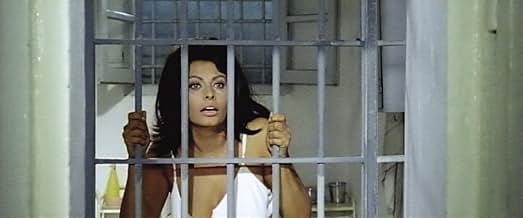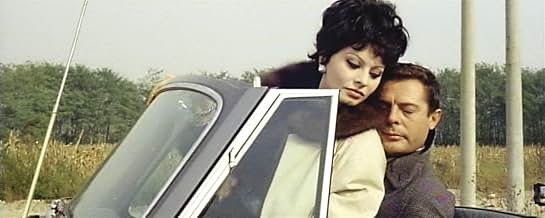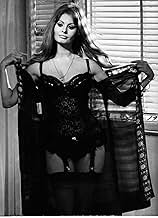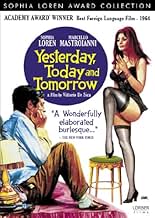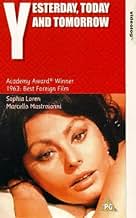AVALIAÇÃO DA IMDb
7,2/10
11 mil
SUA AVALIAÇÃO
Três mulheres muito diferentes, suas histórias e os homens que elas atraem.Três mulheres muito diferentes, suas histórias e os homens que elas atraem.Três mulheres muito diferentes, suas histórias e os homens que elas atraem.
- Direção
- Roteiristas
- Artistas
- Ganhou 1 Oscar
- 8 vitórias e 3 indicações no total
Tonino Cianci
- (segment "Adelina")
- (as Antonio Cianci)
Gianni Ridolfi
- Umberto (segment "Mara")
- (as Giovanni Ridolfi)
Avaliações em destaque
There is such a delightful playfulness to this trio of tales about relationships between men and women in Italy. Sophia Loren is in three different roles – a poor mother in Naples who keeps getting pregnant and having children to postpone being jailed for failing to pay debts on her furniture, a rich woman in Naples who has had a one-night stand while her husband is away at a conference and has picked him up the following day in her Rolls-Royce, and a high-class courtesan who does business out of her apartment overlooking Piazza Navone in Rome, attracting the attention of a young man studying to be a priest. I wouldn't say Loren has exceptional range, but she does turn in a solid performance, and plays feisty, haughty, seductive, angry, and bemused pretty well, all while being quite entertaining. Marcello Mastroianni is her counterpart in each tale (one of the clients in the last, not the young man), and is similarly engaging. It was nice to see him so light on his feet as he moved around in that last tale; his expressions were over-the-top (in a good way), and it was funny to see him ask Loren to dress up as a schoolgirl, and then watch her reaction.
The movie feels quintessentially Italian, as the characters are animated and highly expressive. There is also a feeling of genuine humanity and community. There is an honesty here, as each of the stories quite openly acknowledges sexual urges in both men and women as being natural and a positive thing, which is quite refreshing. At the same time, it remains decent and acknowledges a sense of higher morality. In the first tale, Loren's character is tempted but does not sleep with her brother-in-law when her husband can't get her pregnant again, accepts going to jail, and talks to the prisoners there without an ounce of judgment about why they're there. In the second, Mastroianni's character realizes how shallow Loren's is when she's more concerned about damage to her car after they nearly run over a child. In the third, Loren's character realizes that despite an antagonistic relationship with the young man's grandmother (played fantastically by Tina Pica), she has common ground with her, and must persuade the boy to stay on his path. How nice it is that director Vittorio De Sica shows us that these things – lust and morality – can exist side by side, perfectly well.
The movie feels quintessentially Italian, as the characters are animated and highly expressive. There is also a feeling of genuine humanity and community. There is an honesty here, as each of the stories quite openly acknowledges sexual urges in both men and women as being natural and a positive thing, which is quite refreshing. At the same time, it remains decent and acknowledges a sense of higher morality. In the first tale, Loren's character is tempted but does not sleep with her brother-in-law when her husband can't get her pregnant again, accepts going to jail, and talks to the prisoners there without an ounce of judgment about why they're there. In the second, Mastroianni's character realizes how shallow Loren's is when she's more concerned about damage to her car after they nearly run over a child. In the third, Loren's character realizes that despite an antagonistic relationship with the young man's grandmother (played fantastically by Tina Pica), she has common ground with her, and must persuade the boy to stay on his path. How nice it is that director Vittorio De Sica shows us that these things – lust and morality – can exist side by side, perfectly well.
These three stories very "Italian" indeed, are full of good humour, social observation and correct atmosphere. The direction of De Sica is superb, the acting of Mastroianni and Loren is unique and in the second and third stories we recognize the subtle and superior hand of their author, the great Zavattini. The first story takes place in a very typical popular neighbourhood of Naples where a cigarette pedlar and smuggler (Sofia Loren) discovers that the way of not going to jail for failing to pay a fine, is to get pregnant over and over and giving birth to one child after another with the problems this brings to her exhausted husband (Mastroianni). The second story shows us an aristocratic Milanese rich lady who to escape her boring life gets herself a lover on a social stratum lower to hers and finishes by valuing her Rolls Royce car more than her lover. This is perhaps the not so good of the three stories because it lacks some strength in terms of plot. Finally the third story (maybe the best of the three) is sometimes delirious and hallucinating in its very funny rhythm (Loren's acting is fabulous here) and tells us about a luxury prostitute living near the Piazza Navona in Rome who nevertheless has a soft heart and with whom a neighbour young seminarist falls in love while she plays a game of pull and let go with one of her clients who is anxious to take her to bed most unsuccessfully. This story has a surprising end and a fascinating scene of strip-tease (incomplete of course). You'll have a very amusing time watching this movie.
Italian anthology comedy starring Sophia Loren and Marcello Mastroianni. It's often cited as one of the best films of both stars. There are three stories involving different couples, each played by Loren and Mastroianni. The first has Sophia as a wife who keeps getting pregnant to avoid a jail sentence. It's an amusing story, although it goes on a little long. The second story is about a rich married woman taking a drive with her lover. The segment is pretty dull as it builds up to its punchline. But I suppose that was the point, to make you thing this was an inane soap opera story about whether this woman will choose fortune or love. The question is answered humorously enough but this is still the weakest story in the film. The third story, and the one for which the movie is probably most famous, has Sophia playing a prostitute. Her neighbor's grandson, about to become a priest, falls for Sophia and she must try to set him back on the right path. But, in doing so, she makes a vow that frustrates lustful client Marcello. Sophia's never looked sexier than here and her striptease is legendary.
Of the three stories, the last is the most entertaining but none are bad. Sophia is beautiful and enchanting. She and Marcello are both fun in every segment. It's an enjoyable film, though probably much more so if you are a big fan of Italian cinema to begin with.
Of the three stories, the last is the most entertaining but none are bad. Sophia is beautiful and enchanting. She and Marcello are both fun in every segment. It's an enjoyable film, though probably much more so if you are a big fan of Italian cinema to begin with.
This very enjoyable film may be a let down for someone expecting the heights of De Sica's Neorealist masterpieces like The Bicycle Thief or Two Women. However it is very funny in parts and is pointedly critical of Italian society in the boom years of the 1960s. Also Sophia Loren and Marcello Mastroianni are absolutely stunning to watch.
For people interested in Italy it is a fascinating commentary on the country that can border on stereotype. Naples (De Sica's hometown) is warm and happy and filled with clever types ready to outwit the system and find their own way to happiness. Milan is cold, rich, and callous. Rome is dominated by the Catholic church and the State with plenty of hypocrisy and corruption. But De Sica finds some humor in all of this.
I found it a little too sentimental but well worth watching. I wish a better (undubbed) print were available. De Sica's career was given a boost by the success of the movie and he would continue to make more great films like The Garden of the Finzi-Contini's and the underrated A Brief Vacation that focus on the injustices of the State and the hardships faced by working people.
For people interested in Italy it is a fascinating commentary on the country that can border on stereotype. Naples (De Sica's hometown) is warm and happy and filled with clever types ready to outwit the system and find their own way to happiness. Milan is cold, rich, and callous. Rome is dominated by the Catholic church and the State with plenty of hypocrisy and corruption. But De Sica finds some humor in all of this.
I found it a little too sentimental but well worth watching. I wish a better (undubbed) print were available. De Sica's career was given a boost by the success of the movie and he would continue to make more great films like The Garden of the Finzi-Contini's and the underrated A Brief Vacation that focus on the injustices of the State and the hardships faced by working people.
"Yesterday, Today and Tomorrow" was just the kind of crowd-pleasing, feel-good foreign film that appealed to American audiences and the Academy in 1964. It won the Oscar for Best Foreign Film, the second De Sica film to win in that category after "Bicycle Thieves". Of course, this isn't in the same class as that neo-realist masterpiece. It comprised of three short stories, each starring Sophia Loren and Marcello Mastroianni. In the first she is the wife who avoids prison by getting pregnant; in the second she is a rich socialite having an affair with Mastroianni's writer, that is until he crashes her Rolls while in the third she's a Roman prostitute forced into taking a vow of chastity for a week but not beyond doing the striptease that earned the film its reputation for 'sauciness' and each story is named after the character played by Loren. It's all very jolly, sunny and likable but it's hardly Oscar material. Sophia, however, is splendid throughout.
Você sabia?
- CuriosidadesThe red car that picks up Mara after the accident is an extremely rare 1960 Ferrari 250 GT California Spyder SWB. Only 56 of these cars were made and some have sold for over $10M at auction in the 2010's.
- Erros de gravaçãoAs Anna and Renzo talk while driving, the windshield of her Rolls-Royce Silver Cloud II shakes because the little side windows are gone, but the little side windows are intact in the wide shots.
- Citações
Carmine Sbaratti: The people of Forcella are out of this world. They've risen up in a gesture of solidarity!
Verace's sister: I must say, it almost makes you forget how filthy and ignorant they are.
- ConexõesEdited into Marcello, uma Vida Doce (2006)
Principais escolhas
Faça login para avaliar e ver a lista de recomendações personalizadas
Detalhes
- Data de lançamento
- Países de origem
- Idioma
- Também conhecido como
- Yesterday, Today and Tomorrow
- Locações de filme
- Piazza Navona, Roma, Lazio, Itália(3rd part - Mara's apartment)
- Empresas de produção
- Consulte mais créditos da empresa na IMDbPro
- Tempo de duração1 hora 58 minutos
- Mixagem de som
- Proporção
- 2.35 : 1
Contribua para esta página
Sugerir uma alteração ou adicionar conteúdo ausente

Principal brecha
By what name was Ontem, Hoje e Amanhã (1963) officially released in India in English?
Responda


